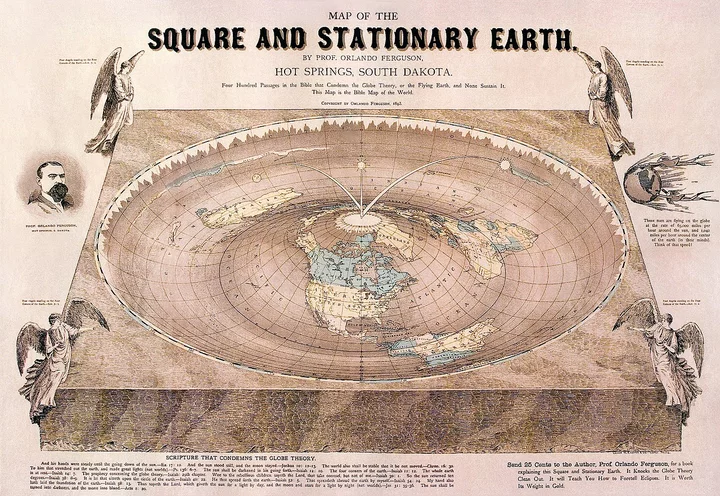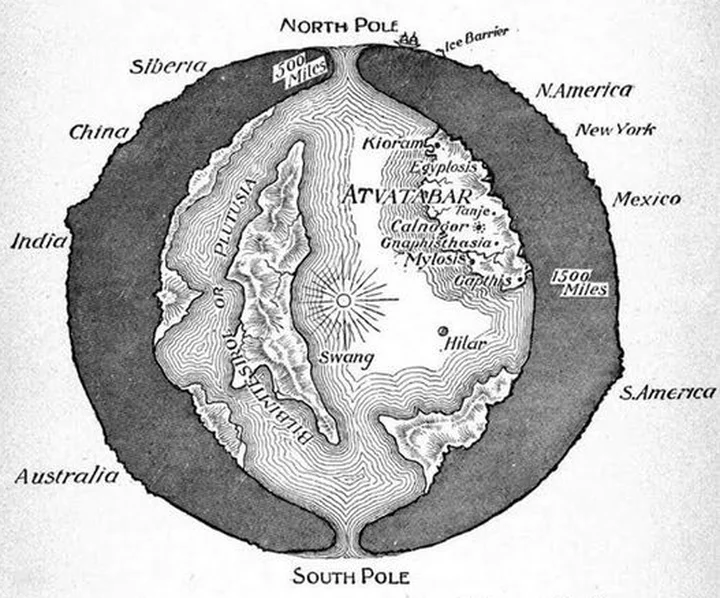… I
saw four angels standing on the four corners of the
earth…
— Revelations 7:1 KJV
###
What happens when a flat-Earther meets a hollow-Earther? Do they mutually annihilate? So they find comfort in dissing those who believe in the 2,5000-year-old nonsense that the Earth is spherical (“The enemy of my enemy is my friend”)? Or do they hammer out a compromise, a model of our home world that embraces both flatness and hollowness?
I was led into this problem by a recent post that popped up, noting that flat-Earthers are on the rise. Again. Seems it dies out every generation, only to resurrect, vampire-like, bright-eyed and bushy-tailed, for a new bunch of brilliant minds to discover. There is, of course, the myth (that is, a myth about a myth) that says most people used to believe the Earth was flat (they didn’t), and that it took Columbus to prove them wrong. Or was it Ferdinand Magellan, who actually circumnavigated the planet between 1519 and 1522?
(Full disclosure: It was originally Magellan’s expedition, but he was killed in the Philippines two years into the voyage. Eighteen of the original crew of 270 completed the circumnavigation, led by Juan Sebastián Elcano in the ship Victoria.)
Lest you think flat-Earthers are a tiny fringe group, check out a 2018 YouGov poll, which found that 66 percent of millennials firmly believe that the earth is round, leaving 34 percent…where? Possibly in church, since the YouGov found a strong link between their belief and religion, with 52 percent of flat-Earthers considering themselves “very religious.”
Orlando Ferguson’s 1893 Flat Earth map. (Library of Congress, public domain)
Along with flat-Earth beliefs, we have been believing in a hollow Earth for a long, long time. Seems, virtually all religions have an underground component: Shamballa is an ancient city inside our planet, according to Tibetan Buddhist teachings; the ancient Greeks thought Hades was where we all went — saints and sinners — when we died; Jewish Kabbalah teaching references Sheol; Celtic mythology includes many underground lands, including Tir na n’Og; Hindus had Patala: while Dante’s Inferno had Lucifer’s fall causing a tear in the previously solid Earth.”
More recently, no less a scientist as astronomer Edmund Halley, he of the comet, proposed in the 1680s that Earth consists of four concentric spheres, the innermost of which is populated. French novelist Jules Verne ran with this in Journey to the Center of the Earth (1864), in which his doughty explorers rappel into Iceland’s Snæfellsjökull (inactive volcano), to be jetted out — unharmed!—by Italy’s Stromboli (active volcano). (The book is much better than the movie, especially when you’re about ten years old.)
Eschewing one-word book titles (Emma, Atonement, Gilead, Homecoming, Middlemarch, It…), Walter Seigmeister, aka Rosicrucian Raymond Bernard gave the whole game away with the title of his 1964 tome: The Hollow Earth: The Greatest Geographical Discovery in History Made by Admiral Richard E. Byrd in the Mysterious Land Beyond the Poles — The True Origin of the Flying Saucers. (He apparently died the following year in South America while searching for the opening to Earth’s interior.)
“The Interior World”, from The Goddess of Atvatabar by William Bradshaw, 1892. (Public domain)
The general idea seems to be that, in lieu of North and South Poles, there are huge — 1,000 miles across — holes accessing the inner Earth, which is illuminated by a miniature sun. The reference to Admiral Byrd is his flights, over the North Pole in 1926 and over the South Pole 1929. You’d think that would put an end to the notion of access points at the poles. No such luck.
As the acronym goes (or used to), BBB: Bullshit Baffles Brains.


CLICK TO MANAGE